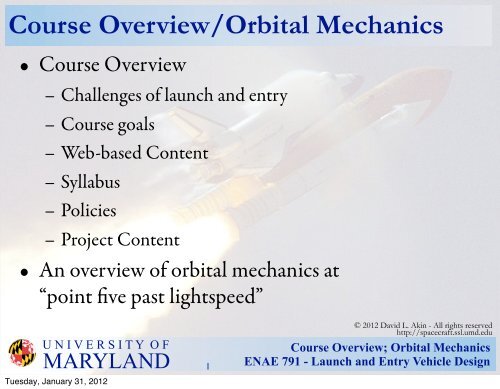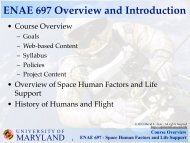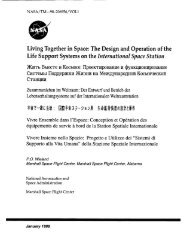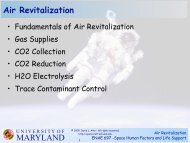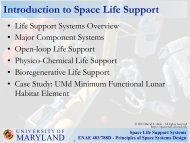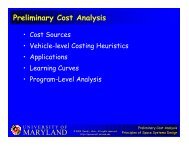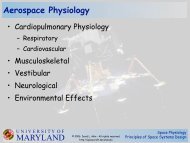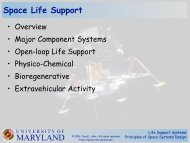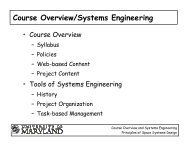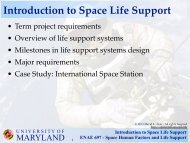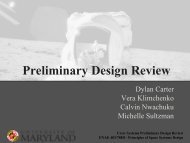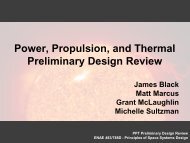Course Overview/Orbital Mechanics - Dave Akin's Web Site
Course Overview/Orbital Mechanics - Dave Akin's Web Site
Course Overview/Orbital Mechanics - Dave Akin's Web Site
Create successful ePaper yourself
Turn your PDF publications into a flip-book with our unique Google optimized e-Paper software.
<strong>Course</strong> <strong>Overview</strong>/<strong>Orbital</strong> <strong>Mechanics</strong><br />
• <strong>Course</strong> <strong>Overview</strong><br />
– Challenges of launch and entry<br />
– <strong>Course</strong> goals<br />
– <strong>Web</strong>-based Content<br />
– Syllabus<br />
– Policies<br />
– Project Content<br />
• An overview of orbital mechanics at<br />
“point five past lightspeed”<br />
U N I V E R S I T Y O F<br />
MARYLAND<br />
Tuesday, January 31, 2012<br />
1<br />
© 2012 David L. Akin - All rights reserved<br />
http://spacecraft.ssl.umd.edu<br />
<strong>Course</strong> <strong>Overview</strong>; <strong>Orbital</strong> <strong>Mechanics</strong><br />
ENAE 791 - Launch and Entry Vehicle Design
Space Launch - The Physics<br />
• Minimum orbital altitude is ~200 km<br />
• Circular orbital velocity there is 7784 m/sec<br />
• Total energy per kg in orbit<br />
U N I V E R S I T Y O F<br />
MARYLAND<br />
Tuesday, January 31, 2012<br />
P otential Energy<br />
kg in orbit<br />
Kinetic Energy<br />
kg in orbit<br />
T otal Energy<br />
kg in orbit<br />
= − µ<br />
= 1<br />
2<br />
rorbit<br />
µ<br />
r 2 orbit<br />
+ µ<br />
rE<br />
6 J<br />
= 1.9 × 10<br />
kg<br />
6 J<br />
= 30 × 10<br />
kg<br />
= KE + P E = 32 × 106 J<br />
kg<br />
2<br />
<strong>Course</strong> <strong>Overview</strong>; <strong>Orbital</strong> <strong>Mechanics</strong><br />
ENAE 791 - Launch and Entry Vehicle Design
Theoretical Cost to Orbit<br />
• Convert to usual energy units<br />
Total Energy<br />
kg in orbit<br />
• Domestic energy costs are ~$0.05/kWhr<br />
eoretical cost to orbit $0.44/kg<br />
U N I V E R S I T Y O F<br />
MARYLAND<br />
Tuesday, January 31, 2012<br />
= 32 × 106 J<br />
kg<br />
3<br />
=8.9 kWhrs<br />
kg<br />
<strong>Course</strong> <strong>Overview</strong>; <strong>Orbital</strong> <strong>Mechanics</strong><br />
ENAE 791 - Launch and Entry Vehicle Design
Actual Cost to Orbit<br />
U N I V E R S I T Y O F<br />
MARYLAND<br />
Tuesday, January 31, 2012<br />
4<br />
• Delta IV Heavy<br />
– 23,000 kg to LEO<br />
– $250 M per flight<br />
• $10,870/kg of payload<br />
• Factor of 25,000x higher<br />
than theoretical energy<br />
costs!<br />
<strong>Course</strong> <strong>Overview</strong>; <strong>Orbital</strong> <strong>Mechanics</strong><br />
ENAE 791 - Launch and Entry Vehicle Design
What About Airplanes?<br />
• For an aircra in level flight,<br />
• Energy = force x distance, so<br />
Total Energy<br />
kg<br />
• For an airliner (L/D=25) to equal orbital energy,<br />
d=81,000 km (2 roundtrips NY-Sydney)<br />
U N I V E R S I T Y O F<br />
MARYLAND<br />
Tuesday, January 31, 2012<br />
Weight<br />
Thrust<br />
= thrust × distance<br />
Lift mg<br />
= , or<br />
Drag T<br />
mass<br />
5<br />
= L<br />
D<br />
= Td<br />
m<br />
= gd<br />
L/D<br />
<strong>Course</strong> <strong>Overview</strong>; <strong>Orbital</strong> <strong>Mechanics</strong><br />
ENAE 791 - Launch and Entry Vehicle Design
Equivalent Airline Costs?<br />
• Average economy ticket NY-Sydney round-roundtrip<br />
(Travelocity 9/3/09) ~$1300<br />
• Average passenger (+ luggage) ~100 kg<br />
• Two round trips = $26/kg<br />
– Factor of 60x more than electrical energy costs<br />
– Factor of 420x less than current launch costs<br />
• But…<br />
you get to refuel at each stop!<br />
U N I V E R S I T Y O F<br />
MARYLAND<br />
Tuesday, January 31, 2012<br />
6<br />
<strong>Course</strong> <strong>Overview</strong>; <strong>Orbital</strong> <strong>Mechanics</strong><br />
ENAE 791 - Launch and Entry Vehicle Design
Equivalence to Air Transport<br />
U N I V E R S I T Y O F<br />
MARYLAND<br />
Tuesday, January 31, 2012<br />
7<br />
• 81,000 km ~<br />
twice around the<br />
world<br />
• Voyager - one of<br />
two aircra to<br />
ever circle the<br />
world non-stop,<br />
non-refueled -<br />
once!<br />
<strong>Course</strong> <strong>Overview</strong>; <strong>Orbital</strong> <strong>Mechanics</strong><br />
ENAE 791 - Launch and Entry Vehicle Design
<strong>Orbital</strong> Entry - The Physics<br />
• 32 MJ/kg dissipated by friction with atmosphere<br />
over ~8 min = 66kW/kg<br />
• Pure graphite (carbon) high-temperature material:<br />
c p =709 J/kg°K<br />
• <strong>Orbital</strong> energy would cause temperature gain of<br />
45,000°K!<br />
• us proving the comment about space travel, “It’s<br />
utter bilge!” (Sir Richard Wooley, Astronomer Royal<br />
of Great Britain, 1956)<br />
U N I V E R S I T Y O F<br />
MARYLAND<br />
Tuesday, January 31, 2012<br />
8<br />
<strong>Course</strong> <strong>Overview</strong>; <strong>Orbital</strong> <strong>Mechanics</strong><br />
ENAE 791 - Launch and Entry Vehicle Design
The Vision<br />
“Once you make it to low Earth<br />
orbit, you’re halfway to anywhere!”<br />
U N I V E R S I T Y O F<br />
MARYLAND<br />
Tuesday, January 31, 2012<br />
- Robert A. Heinlein<br />
9<br />
<strong>Course</strong> <strong>Overview</strong>; <strong>Orbital</strong> <strong>Mechanics</strong><br />
ENAE 791 - Launch and Entry Vehicle Design
Goals of ENAE 791<br />
• Learn the underlying physics (orbital mechanics,<br />
flight mechanics, aerothermodynamics) which<br />
constrain and define launch and entry vehicles<br />
• Develop the tools for preliminary design synthesis,<br />
including the fundamentals of systems analysis<br />
• Provide an introduction to engineering economics,<br />
with a focus on the parameters affecting cost of<br />
launch and entry vehicles, such as reusability<br />
• Examine specific challenges in the underlying design<br />
disciplines, such as thermal protection and structural<br />
dynamics<br />
U N I V E R S I T Y O F<br />
MARYLAND<br />
Tuesday, January 31, 2012<br />
10<br />
<strong>Course</strong> <strong>Overview</strong>; <strong>Orbital</strong> <strong>Mechanics</strong><br />
ENAE 791 - Launch and Entry Vehicle Design
Contact Information<br />
Dr. <strong>Dave</strong> Akin<br />
Space Systems Laboratory<br />
Neutral Buoyancy Research Facility/Room 2100D<br />
301-405-1138<br />
dakin@ssl.umd.edu<br />
http://spacecra.ssl.umd.edu<br />
U N I V E R S I T Y O F<br />
MARYLAND<br />
Tuesday, January 31, 2012<br />
11<br />
<strong>Course</strong> <strong>Overview</strong>; <strong>Orbital</strong> <strong>Mechanics</strong><br />
ENAE 791 - Launch and Entry Vehicle Design
<strong>Web</strong>-based <strong>Course</strong> Content<br />
• Data web site at http://spacecra.ssl.umd.edu<br />
– <strong>Course</strong> information<br />
– Syllabus<br />
– Lecture notes<br />
– Problems and solutions<br />
• Interactive web site at http://elms.umd.edu<br />
– Communications for team projects (forums, wiki, blogs)<br />
– Surveys for course feedback<br />
– Videos of lectures<br />
U N I V E R S I T Y O F<br />
MARYLAND<br />
Tuesday, January 31, 2012<br />
12<br />
<strong>Course</strong> <strong>Overview</strong>; <strong>Orbital</strong> <strong>Mechanics</strong><br />
ENAE 791 - Launch and Entry Vehicle Design
Syllabus <strong>Overview</strong> (1)<br />
• Fundamentals of Launch and Entry Design<br />
– <strong>Orbital</strong> mechanics<br />
– Basic rocket performance<br />
• Entry flight mechanics<br />
– Ballistic entry<br />
– Liing entry<br />
• Aerothermodynamics<br />
• ermal Protection System (TPS) analysis<br />
• Entry, Descent, and Landing (EDL) systems<br />
U N I V E R S I T Y O F<br />
MARYLAND<br />
Tuesday, January 31, 2012<br />
13<br />
<strong>Course</strong> <strong>Overview</strong>; <strong>Orbital</strong> <strong>Mechanics</strong><br />
ENAE 791 - Launch and Entry Vehicle Design
Syllabus <strong>Overview</strong> (2)<br />
• Launch flight mechanics<br />
– Gravity turn<br />
– Targeted trajectories<br />
– Optimal trajectories<br />
– Airbreathing trajectories<br />
• Launch vehicle systems<br />
– Propulsion systems<br />
– Structures and structural dynamics analysis<br />
– Avionics<br />
– Payload accommodations<br />
– Ground launch processing<br />
U N I V E R S I T Y O F<br />
MARYLAND<br />
Tuesday, January 31, 2012<br />
14<br />
<strong>Course</strong> <strong>Overview</strong>; <strong>Orbital</strong> <strong>Mechanics</strong><br />
ENAE 791 - Launch and Entry Vehicle Design
Syllabus <strong>Overview</strong> (3)<br />
• Systems Analysis<br />
– Cost estimation<br />
– Engineering economics<br />
– Reliability issues<br />
– Safety design concerns<br />
– Fleet resiliency<br />
– Multidisciplinary optimization<br />
• Case studies<br />
• Design project<br />
U N I V E R S I T Y O F<br />
MARYLAND<br />
Tuesday, January 31, 2012<br />
15<br />
<strong>Course</strong> <strong>Overview</strong>; <strong>Orbital</strong> <strong>Mechanics</strong><br />
ENAE 791 - Launch and Entry Vehicle Design
Policies<br />
• Grade Distribution<br />
– 25% Problems<br />
– 20% Midterm Exam<br />
– 25% Term Project<br />
– 30% Final Exam<br />
• Late Policy<br />
– On time: Full credit<br />
– Before solutions: 70% credit<br />
– Aer solutions: 20% credit<br />
U N I V E R S I T Y O F<br />
MARYLAND<br />
Tuesday, January 31, 2012<br />
16<br />
<strong>Course</strong> <strong>Overview</strong>; <strong>Orbital</strong> <strong>Mechanics</strong><br />
ENAE 791 - Launch and Entry Vehicle Design
A Word on Homework Submissions...<br />
• Good methods of handing in homework<br />
– Hard copy in class (best!)<br />
– Scanned copies via e-mail<br />
(please put “ENAE791”in the subject line)<br />
• Methods that don’t work so well<br />
– Leaving it in my mailbox (particularly in EGR)<br />
– Leaving it in my office<br />
– Spreadsheets or .m files<br />
– Handing it to me in random locations<br />
– Handing it to Dr. Bowden<br />
U N I V E R S I T Y O F<br />
MARYLAND<br />
Tuesday, January 31, 2012<br />
17<br />
<strong>Course</strong> <strong>Overview</strong>; <strong>Orbital</strong> <strong>Mechanics</strong><br />
ENAE 791 - Launch and Entry Vehicle Design
A Word about Homework Grading<br />
• Homework is graded via a discrete filter<br />
– ✓ for homework problems which are essentially correct<br />
(10 pts)<br />
– ✓- for homework with significant problems (7 pts)<br />
– ✓-- for homework with major problems (4 pts)<br />
– ✓+ for homework demonstrating extra effort (12 pts)<br />
– 0 for missing homework<br />
• A detailed solution document is posted for each<br />
problem aer the due date, which you should review<br />
to ensure you understand the techniques used<br />
U N I V E R S I T Y O F<br />
MARYLAND<br />
Tuesday, January 31, 2012<br />
18<br />
<strong>Course</strong> <strong>Overview</strong>; <strong>Orbital</strong> <strong>Mechanics</strong><br />
ENAE 791 - Launch and Entry Vehicle Design
Term Project - Solar Power Satellites<br />
U N I V E R S I T Y O F<br />
MARYLAND<br />
Tuesday, January 31, 2012<br />
19<br />
<strong>Course</strong> <strong>Overview</strong>; <strong>Orbital</strong> <strong>Mechanics</strong><br />
ENAE 791 - Launch and Entry Vehicle Design
Term Project - Top Level Requirements<br />
• Design a system to allow the construction of one<br />
10GW SPS per year<br />
– Launch vehicle(s) for cargo and personnel<br />
– Crew-carrying spacecra<br />
– On-orbit transportation infrastructure<br />
– Assembly base(s) siting analysis<br />
– Spacecra launch abort and EDL systems<br />
• Mission models<br />
– 4000 MT/year for SPS components<br />
– All other logistics over and above SPS payloads<br />
U N I V E R S I T Y O F<br />
MARYLAND<br />
Tuesday, January 31, 2012<br />
20<br />
<strong>Course</strong> <strong>Overview</strong>; <strong>Orbital</strong> <strong>Mechanics</strong><br />
ENAE 791 - Launch and Entry Vehicle Design
SPS Operational Scenario (NASA - 1981)<br />
U N I V E R S I T Y O F<br />
MARYLAND<br />
Tuesday, January 31, 2012<br />
21<br />
<strong>Course</strong> <strong>Overview</strong>; <strong>Orbital</strong> <strong>Mechanics</strong><br />
ENAE 791 - Launch and Entry Vehicle Design
Term Project<br />
• Form your own teams (~3-4/team)<br />
• Design an architecture to support SPS construction<br />
and operations in the most cost effective manner<br />
possible<br />
• All vehicles will be conceptually designed from<br />
scratch (no “catalog engineering”!)<br />
• Parametric design parameters will be provided for<br />
human spacecra systems not ENAE791-relevant<br />
• Design process should proceed throughout the term<br />
• Formal design presentations at end of term<br />
U N I V E R S I T Y O F<br />
MARYLAND<br />
Tuesday, January 31, 2012<br />
22<br />
<strong>Course</strong> <strong>Overview</strong>; <strong>Orbital</strong> <strong>Mechanics</strong><br />
ENAE 791 - Launch and Entry Vehicle Design
<strong>Orbital</strong> <strong>Mechanics</strong>: 500 years in 40 min.<br />
• Newton’s Law of Universal Gravitation<br />
• Newton’s First Law meets vector algebra<br />
U N I V E R S I T Y O F<br />
MARYLAND<br />
Tuesday, January 31, 2012<br />
F = Gm1m2<br />
r2 −→ F = m −→ a<br />
23<br />
<strong>Course</strong> <strong>Overview</strong>; <strong>Orbital</strong> <strong>Mechanics</strong><br />
ENAE 791 - Launch and Entry Vehicle Design
<strong>Orbital</strong> Angular Momentum<br />
U N I V E R S I T Y O F<br />
MARYLAND<br />
Tuesday, January 31, 2012<br />
h is angular momentum vector (constant) =⇒<br />
r and v are in a constant plane<br />
26<br />
<strong>Course</strong> <strong>Overview</strong>; <strong>Orbital</strong> <strong>Mechanics</strong><br />
ENAE 791 - Launch and Entry Vehicle Design
Fun and Games with Algebra<br />
U N I V E R S I T Y O F<br />
MARYLAND<br />
Tuesday, January 31, 2012<br />
27<br />
<strong>Course</strong> <strong>Overview</strong>; <strong>Orbital</strong> <strong>Mechanics</strong><br />
ENAE 791 - Launch and Entry Vehicle Design<br />
0
More Algebra, More Fun<br />
U N I V E R S I T Y O F<br />
MARYLAND<br />
Tuesday, January 31, 2012<br />
28<br />
<strong>Course</strong> <strong>Overview</strong>; <strong>Orbital</strong> <strong>Mechanics</strong><br />
ENAE 791 - Launch and Entry Vehicle Design
Position in Orbit<br />
θ = true anomaly: angular travel from perigee passage<br />
U N I V E R S I T Y O F<br />
MARYLAND<br />
Tuesday, January 31, 2012<br />
30<br />
<strong>Course</strong> <strong>Overview</strong>; <strong>Orbital</strong> <strong>Mechanics</strong><br />
ENAE 791 - Launch and Entry Vehicle Design
Relating Velocity and <strong>Orbital</strong> Elements<br />
U N I V E R S I T Y O F<br />
MARYLAND<br />
Tuesday, January 31, 2012<br />
31<br />
<strong>Course</strong> <strong>Overview</strong>; <strong>Orbital</strong> <strong>Mechanics</strong><br />
ENAE 791 - Launch and Entry Vehicle Design
Energy in Orbit<br />
• Kinetic Energy<br />
K.E. = 1<br />
2 mν 2 ⇒ K.E.<br />
m<br />
• Potential Energy<br />
• Total Energy<br />
U N I V E R S I T Y O F<br />
MARYLAND<br />
Tuesday, January 31, 2012<br />
P.E. = − mµ P.E.<br />
⇒<br />
r m<br />
Const. = v2<br />
2<br />
− µ<br />
r<br />
33<br />
= − µ<br />
2a<br />
= v2<br />
2<br />
= − µ<br />
r<br />
Suborbital Tourism - Spaceship Two<br />
U N I V E R S I T Y O F<br />
MARYLAND<br />
Tuesday, January 31, 2012<br />
34<br />
<strong>Course</strong> <strong>Overview</strong>; <strong>Orbital</strong> <strong>Mechanics</strong><br />
ENAE 791 - Launch and Entry Vehicle Design
How Close are we to Space Tourism?<br />
• Energy for 100 km vertical climb<br />
µ<br />
−<br />
rE + 100 km<br />
• Energy for 200 km circular orbit<br />
• Energy difference is a factor of 33!<br />
U N I V E R S I T Y O F<br />
MARYLAND<br />
Tuesday, January 31, 2012<br />
µ<br />
−<br />
2(rE + 200 km)<br />
+ µ<br />
rE<br />
+ µ<br />
rE<br />
35<br />
= 0.965 km2 MJ<br />
= 0.965<br />
sec2 kg<br />
= 32.2 km2 MJ<br />
= 32.2<br />
sec2 kg<br />
<strong>Course</strong> <strong>Overview</strong>; <strong>Orbital</strong> <strong>Mechanics</strong><br />
ENAE 791 - Launch and Entry Vehicle Design
Implications of Vis-Viva<br />
• Circular orbit (r=a)<br />
• Parabolic escape orbit (a tends to infinity)<br />
• Relationship between circular and parabolic orbits<br />
U N I V E R S I T Y O F<br />
MARYLAND<br />
Tuesday, January 31, 2012<br />
vcircular =<br />
vescape =<br />
µ<br />
r<br />
2µ<br />
r<br />
vescape = √ 2vcircular<br />
36<br />
<strong>Course</strong> <strong>Overview</strong>; <strong>Orbital</strong> <strong>Mechanics</strong><br />
ENAE 791 - Launch and Entry Vehicle Design
Some Useful Constants<br />
• Gravitation constant µ = GM<br />
– Earth: 398,604 km<br />
– Moon: 4667.9 km<br />
– Mars: 42,970 km<br />
U N I V E R S I T Y O F<br />
MARYLAND<br />
3/sec 2<br />
3/sec 2<br />
3/sec 2<br />
– Sun: 1.327x10 11 km<br />
• Planetary radii<br />
– r Earth = 6378 km<br />
– r Moon = 1738 km<br />
– r Mars = 3393 km<br />
Tuesday, January 31, 2012<br />
3/sec 2<br />
37<br />
<strong>Course</strong> <strong>Overview</strong>; <strong>Orbital</strong> <strong>Mechanics</strong><br />
ENAE 791 - Launch and Entry Vehicle Design
Classical Parameters of Elliptical Orbits<br />
U N I V E R S I T Y O F<br />
MARYLAND<br />
Tuesday, January 31, 2012<br />
38<br />
<strong>Course</strong> <strong>Overview</strong>; <strong>Orbital</strong> <strong>Mechanics</strong><br />
ENAE 791 - Launch and Entry Vehicle Design


